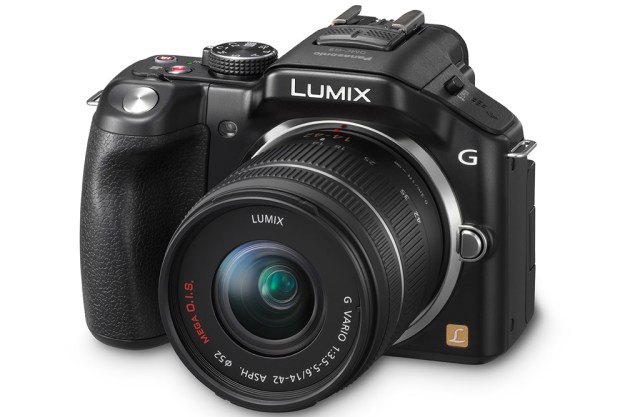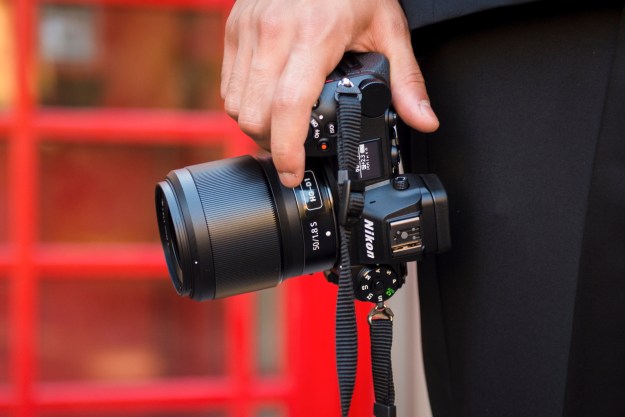
“For anyone looking to trade up from a point-and-shoot but isn’t ready to dive into the realm of DSLRs, the Lumix G5 is an excellent in-between that offers the best of both worlds.”
- Excellent build quality
- Loaded with features designed with novices in mind
- Intelligent Auto mode effective
- DSLR-like operation
- Fast autofocus, and good image quality
- The compact size may not fit well with larger hands
- Touchscreen isn’t as responsive as it should be in the age of smartphones
- Zoom ring on included lens a bit stiff to turn
Based on looks alone, Panasonic’s Lumix DMC-G5 resembles any compact DSLR on the market. It has the familiar DSLR shape with a lens barrel, right-hand grip, and sturdy build. But take one into your hands and you’ll notice that the small size and lighter weight makes it anything but a traditional SLR. As part of Panasonic’s G-series line of Micro Four-Thirds mirrorless, interchangeable-lens cameras, the G5 walks in the same footsteps as the original G1, announced back in 2008. The G5 is the ideal shooter for those wanting to step up from a compact digicam, but not fully prepared to enter the DSLR segment. It has the flexibility, optical quality, and prowess of an entry-level DSLR, but is designed to operate like a fully automated camera with a touchscreen LCD. And that’s not a bad thing.
Look and feel
For our review, Panasonic provided us with the DMC-G5K, a kit that includes the G5 body and a Lumix 14-42mm interchangeable lens (H-FS014042). The G5 is available in black, white, and silver.
When you grab onto it, you will notice right away the solid metal build quality, especially if you’re stepping up from a less-substantial camera. Compact DSLR users will find it familiar, although the camera is noticeably smaller and weighs approximately 1.2 pounds.
On the front, you have a traditional lens mount that is compatible with other Panasonic Micro Four-Thirds lenses. Up top, the G5 continues the DSLR look and feel with a hot shoe, a toggle to pop up the built-in flash, mode dial with on/off toggle, shutter button, dedicated video-record and Intelligent Auto buttons, and a function rocker button (can be used for zooming with certain lenses or exposure compensation). Also on top is a built-in stereo microphone and speaker for use when recording video.
On the back, a large tiltable, flip-out, 3-inch, LCD touchscreen covers most of the surface. You will also find an electronic viewfinder, several function buttons (including the Q.MENU button that gives you direct access to often-used settings), a left-right dial (for exposure compensation or to scroll and select between menu options), a four-way cursor button, and a thumb grip.

The G5’s design and button locations let users easily operate the camera mostly with the right hand’s thumb and index finger, thanks to the compact size of the frame. After a bit of use, you can navigate the buttons intuitively while viewing through the viewfinder. Those with significantly larger hands, however, may find that they can’t get a completely firm grip on the camera. And, although it can be done, it’s heavy enough that you should hold the camera with both hands (especially when you need to hold the camera steady.) With the 14-45mm kit lens, we found the zoom ring a bit stiffer than what we are used to. Some of the buttons on the camera are slightly more recessed than others, but that didn’t inhibit operation. When we stashed the camera in our rucksack, the lens cap frequently popped off, which was annoying. We recommend a dedicated bag to store this camera.
Design-wise overall, the issues we encountered are fairly minor. In fact, the G5 is a significantly better-designed camera when compared to its predecessors, the G3 and G1, with a more pronounced grip and ideal button locations that make the camera more enjoyable to use. It’s closer to a traditional DSLR in look and feel than the older models.
In the box
The DMC-G5K includes the H-FS014042 interchangeable lens, lens hood, lens cap, lens rear cap, body cap, battery pack (DMW-BLC12PP), battery charger (DE-A79B), a proprietary USB cable, a basic startup manual, and CDs containing the full owner’s manual and software for editing photos and video.
User interface and navigation
The 3-inch LCD is a 920,000-pixel display that’s visible in low and bright light. It also folds out and can be tilted 270 degrees up and down, allowing you to capture shots from up high or down low that are normally difficult.
The screen is also touch capable. It lets you select functions or make adjustments by tapping on the screen. You can focus by tapping where the subject is located, and use the “touch shutter” function to snap the shot instead of pressing on the physical shutter button. The screen was able to keep up without experiencing any lag when we panned the camera around, which makes it great for shooting moving objects. For anyone who has taken photos with a smartphone, this will seem familiar. But unlike a

Advanced users will probably avoid using the LCD except for playback from the get-go, but for those stepping up from a basic camera, the touchscreen and UI serve as a bridge to learning more about the advanced features. There is some handholding available in the menus, too, as many of the features have some type of description that lets the user know what it’s for and how it could be used. Eventually, even beginner users will move away from using the LCD to take photos and use the viewfinder like the pros do, once they become more familiar with the camera.
Features
The G5 incorporates Panasonic’s new 16-megapixel Live MOS sensor and a redesigned Venus signal-processing engine. It has an ISO range of 160 to 12,800 and, with our included lens, an aperture of F3.5 to F22. It accepts SD cards up to SDXC.
The G5 is loaded with features that serve both beginner photographers and advanced users. At the high end, you will find aperture priority, shutter priority, manual and program modes, typical settings you would find in a traditional SLR. At the low end there are 23 scene modes and an Intelligent Auto mode, plus features you would normally find in compact
Intelligent Auto can be activated regardless of the mode you are in, simply by pressing the red button marked “iA.” As you would expect, in this mode the camera takes control of all settings. Within this mode there’s also an Intelligent Auto Plus mode, which lets you control defocus (to adjust the blurriness of the background), exposure, and white balance, but nothing else. While we normally avoid using auto modes, the Intelligent Auto mode was quite effective during our use. In fact, in certain situations the Intelligent Auto mode chose similar settings to what we did while working in the more advanced modes. We like that you can easily enter in and out of the mode, and wouldn’t mind ceding control of the camera to it for general photo taking.
We didn’t care much for the scene modes. We found that the Intelligent Auto was adequate or worked better in most instances. The one benefit for beginners is that the scene modes are a good way to learn how to take photos in those scenes. Learn what the scene modes suggest in terms of settings, and then try improving upon them in a mode that lets you manipulate those settings.

Panasonic has included 14 filter options in the Creative Control Mode, up from five in the G3. You can preview on the LCD how your shot would look with the added filter, such as sepia, dynamic monochrome, and miniature effect. When you’re framing a shot in Intelligent Auto mode, the camera may also recommend a filter based on the conditions, which you can select when you see a palette icon appear onscreen. The use of these filters is subjective. We don’t use them in our day-to-day photo taking, but it doesn’t mean you shouldn’t.
Like many new cameras, the G5 can record high-definition video at 1080p resolution (1920 x 1080) and stereo sound with the built-in microphone. With the included lens, the camera has a continuous recording time of 140 minutes on a 4GB SDHC card. Upon playback on our computer, we found the video quality to be acceptable, but not as sharp as we have seen with other cameras.
Performance and use
For the most part, the G5 takes exceptionally good-looking pictures in most situations right out of the box. Colors are well saturated, and images shot at ISO 100 to 1600 are generally sharp with little to no noise, although noise starts to creep in once you push past ISO 1600. Besides the fast autofocus, there was little lag time between shots.
We were actually surprised how well the G5 operated in low light. We expected a fair amount of noise, especially when the camera is hand-held. But many of the photos we shot were quite useable, albeit soft and with noticeable noise when viewed at full size. Of course, we encountered the most noise and issues when we raised the ISO levels and adjusted the exposure compensation. If you’re don’t plan to blow up the images, they will look fine at smaller sizes.
As mentioned, we found the Intelligent Auto mode to be quite good for everyday shooting, even in some low-light conditions. We ventured into program and aperture priority-mode when we thought a picture could be better enhanced by playing with the light sensitivity or depth of field, but for the most part, Intelligent Auto mode works, which is good news for beginners.
Battery life is good. The camera lasted about three days of regular use before dipping into the one-bar territory.
Conclusion
The Lumix G5 is a great camera for those who are ready to go beyond their restrictive point-and-shoot models but aren’t ready to commit to a DSLR. It’s one of the better Micro Four-Thirds cameras on the market, offering both manual and auto controls. For casual photographers moving into this space, they may feel intimidated by the multiple buttons and options at hand, but after some use they should feel more comfortable experimenting with the settings. Even if they never do, the Intelligent Auto setting does a decent job taking good photos in most circumstances. DSLR purists may dismiss such cameras, but even they would find the G5’s manual controls and performance acceptable. At $699, it’s not an inexpensive camera (you can find some entry-level DSLR with a kit lens at that price), but the G5 tries to offer the best of all worlds in a compact DSLR-like body.
Should you buy it?
For anyone looking to trade up from a point-and-shoot but isn’t ready to dive into the realm of DSLRs, the Lumix G5 is an excellent in-between that offers the best of both worlds.
Highs
- Excellent build quality
- Loaded with features designed with novices in mind
- Intelligent Auto mode effective
- DSLR-like operation
- Fast autofocus, and good image quality
Lows
- The compact size may not fit well with larger hands
- Touchscreen isn’t as responsive as it should be in the age of smartphones
- Zoom ring on included lens a bit stiff to turn
Editors' Recommendations
- The best point-and-shoot cameras
- The Panasonic Lumix S5: Everything we know
- The $600 Panasonic Lumix S 20-60mm is a unique, affordable zoom
- Leica SL2 vs Panasonic Lumix S1R: Two L-mount leaders with one big difference
- Panasonic Lumix S1H camera will offer limitless 6K recording for $4,000









